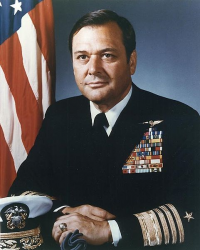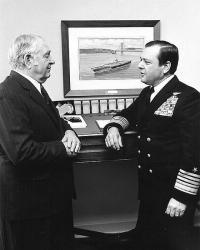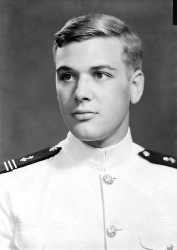
 |
|
|
||
|
James Lemuel Holloway, III |
||||
|
Graduate, U.S. Naval Academy, Class of 1943 Engagements: • World War II (1941 - 1945)• Korean War (1950 - 1953)• Vietnam War (1960 - 1973) |
||||
| Biography: | ||||
|
James Lemuel Holloway III Admiral, U.S. Navy James Lemuel Holloway III was born on 23 February 1922 in Charleston, SC, the son of then-Lieutenant (Junior Grade) James L. Holloway, Jr. (1898-1984), later a four-star Admiral. He graduated from Saint James School, MD, in 1939 and was appointed to the U.S. Naval Academy in that year as a member of the Class of 1943. Holloway graduated from the Academy in June 1942 as a member of the first three-year class accelerated by World War II. Naval Career In WWII, he served in destroyers on North Atlantic convoy duty, in North African waters and in the Pacific where he participated in the Saipan, Tinian, and Palaus Campaigns and the Battle of Leyte Gulf. He was Gunnery Officer of the destroyer USS Bennion which, at the Battle of Surigao Strait, took part in a night torpedo attack which sank the Japanese battleship Yamashiro; assisted in the destruction of the destroyer Asagumo; attacked the cruiser Mogami with torpedoes; and then. the following day, shot down two Japanese Zeroes at short range. For this service, he received the Bronze Star and Navy Commendation Medals. After World War II, he became a naval aviator. He made two carrier tours to Korea, flying Grumman F9F-2 Panther jets on combat missions against the North Korean and Chinese Communists. He assumed command of Fighting Squadron 52 (VF-52) when his commanding officer was shot down. He was awarded the Distinguished Flying Cross and three Air Medals during the Korean War, and shared in a Navy Unit Commendation awarded to the aircraft carrier USS Valley Forge. In 1958, as Commanding Officer of Attack Squadron 83 (VA-83), flying Douglas A-4 Skyhawks from the carrier USS Essex, he covered the Marine landings in Lebanon and flew patrols in support of U.S. operations there until Essex was redeployed through the Suez Canal to join the 7th Fleet in the Formosa Straits. There, he flew missions in defense of Quemoy and Matsu against the threat of a Chinese Communist invasion of those offshore islands. From 1965-67, he commanded the carrier USS Enterprise, the Navy's first, and at that time, only nuclear-powered aircraft carrier for two combat cruises in the Gulf of Tonkin against the North Vietnamese. Enterprise established a record for the number of combat sorties flown, won the Battle Efficiency "E" award for the best carrier in the fleet, and was awarded a Navy Unit Commendation. He twice received the Legion of Merit for his leadership. Returning to the Pentagon in 1968, he established the Navy's Nuclear Powered Carrier Program, building the supercarrier USS Nimitz and paving the way for nine more supercarriers of this class. He was awarded the Navy's Distinguished Service Medal for this achievement. In 1970, he was Commander of the Carrier Striking Force of the 6th Fleet and deployed to the Eastern Mediterranean to conduct carrier air operations in reaction to the Syrian invasion of Jordan. After the strong U.S. military response brought about the withdrawal of the Syrian forces, his task force covered the evacuation of an Army MASH (Mobile Army Surgical Hospital) unit from Amman, Jordan, by a Marine Expeditionary Group. For his performance of duty he was awarded a second Distinguished Service Medal and shared in a Meritorious Unit Commendation awarded to his flagship, the carrier USS Independence. He took command of the 7th Fleet in 1972 during the Vietnam War, and personally led a cruiser-destroyer gunfire strike against the main North Vietnamese port of Haiphong. During Operation Linebacker II, he directed the massive carrier strikes against Hanoi which were a part of the intensive joint air effort which led to the Vietnam cease-fire in 1973. Under his command, the 7th Fleet subsequently performed the airborne mine clearing operations in North Vietnam ports in accordance with the terms of the Paris Peace Accords. For duty as Commander, 7th Fleet, he received a third Distinguished Service Medal. On 1 September 1973, he was promoted to the four-star rank of Admiral and appointed as Vice Chief of Naval Operations (VCNO). In 1974 he was named Chief of Naval Operations (CNO) and served from 1974-78. As CNO he was a member of the Joint Chiefs of Staff (JCS), and served as Chairman of the JCS during the evacuation of Cyprus; the rescue of the merchant ship SS Mayaguez and its crew, and punitive strike operations against the Cambodian forces involved in its seizure; the evacuation of U.S. nationals from Lebanon; and the Korean DMZ (demilitarized zone) incident in August 1976, which led to an ultimatum and an armed standoff between the Allied and North Korean armies before the North Koreans backed down. For this service, he was presented a fourth Navy Distinguished Service Medal and two awards of the Defense Distinguished Service Medal. Admiral Holloway retired from the Navy in 1978. Medals and Awards Defense Distinguished Service Medal (2 Awards) Honors • Recipient of the triennial Modern Patriot Award from the General Society of the Sons of the American Revolution in 1994. • Recipient of the National Navy League Award for Outstanding Civilian Leadership in 1997. • In 1998, he was elected to the National Amateur Wrestling Hall of Fame. • In 2000, he was selected by the U.S. Naval Academy Alumni Association to receive the Distinguished Graduate Award for service to the Navy and the Naval Academy. • He was enshrined in the National Museum of Naval Aviation's Hall of Honor in 2004. In Retirement After retiring from the Navy in 1978, Admiral Holloway was a consultant to Paine Webber, Inc. and served until 1988 as President of the Council of American-Flag Ship Operators, a national association of U.S. merchant marine companies. In 1980, he chaired the Special Operations Review Group which investigated the aborted Iranian hostage rescue attempt. In 1985, he served as Executive Director of Vice President Bush's Task Force on Combating Terrorism, and was a member of the President's Blue Ribbon Commission on Defense Management. In 1986, he was appointed as a Special Envoy of the Vice President to the Middle East. Later, he was a member of the Commission on Merchant Marine and Defense and the Defense Commission on Long Term Integrated Strategy. In 1985, Admiral Holloway was the Technical Advisor to the film Top Gun. Subsequently, he has been Chairman of the Academic Advisory Board of the U.S. Naval Academy, Chairman of the Association of Naval Aviation, a Director of the Olmsted Foundation, a Trustee of the George C. Marshall Foundation, served on the Board of Visitors and Governors of St. John's College and served in a Presidential appointment as U.S. Representative to the South Pacific Commission. Admiral Holloway has been conspicuous in his personal support for the Navy's official history programs run by the Naval History & Heritage Command. His generous grant made the Online Dictionary of American Naval Fighting Ships Project possible, thereby opening one of the most important U.S. naval history resources to a world-wide audience. Currently, he is Chairman Emeritus of the Naval Historical Foundation and the Historic Annapolis Foundation, the Board of Trustees of Saint James School, and as an Emeritus member of the Board of the Mariners' Museum. He is a member of the Society of the Cincinnati, the Brook Club (New York City), Maryland Club (Baltimore, MD), New York Yacht Club, Annapolis Yacht Club, and the Metropolitan Club of Washington, DC, where he served as President in 1992. |
||||
| Honoree ID: 552 | Created by: MHOH | |||
Ribbons
Medals
Badges
Honoree Photos
 |  |  |
 |  |
 |


